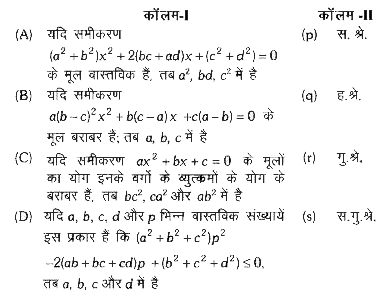माना P(x)=a0+a1x+.....+anxn यदि P(−2)=−15,P(−1)=1P(0)=7,P(1)=9,P(2)=13 और P(3)=25 हो, तब n का न्यूनतम संभव मान है
5
4
3
2
The correct Answer is:C
Topper's Solved these Questions
- वर्ग समीकरण एवं असमिकायें BOOK - ERRORLESS HINDICHAPTER - वर्ग समीकरण एवं असमिकायें EXERCISE - Solved Multiple Choice Questions (मूलों तथा गुणांकों के मध्य सम्बन्ध)
58 Videos
- वर्ग समीकरण एवं असमिकायें BOOK - ERRORLESS HINDICHAPTER - वर्ग समीकरण एवं असमिकायें EXERCISE - Solved Multiple Choice Questions (मूलों के उभयनिष्ठ होने का प्रतिबंध, वर्ग व्यंजक व मूलों की स्थिति)
18 Videos
- वर्ग समीकरण एवं असमिकायें BOOK - ERRORLESS HINDICHAPTER - वर्ग समीकरण एवं असमिकायें EXERCISE - JEE Advanced (Matrix Match type questions)
2 Videos
- लघुगणक और आंशिक भिन्नें BOOK - ERRORLESS HINDICHAPTER - लघुगणक और आंशिक भिन्नें EXERCISE - JEE Advanced (integer type questions)
8 Videos
- वृत्त तथा वृत्तों का निकाय BOOK - ERRORLESS HINDICHAPTER - वृत्त तथा वृत्तों का निकाय EXERCISE - JEE Advanced (Integer type questions)
20 Videos
Similar Questions
यदि α तथा β समीकरण 4x2+3x+7=0 के मूल हों, तो 1α+1β=
If α and β are roots of 4x2+3x+7=0 then value of 1α+1β= is
View Solutionयदि दो समीकरणों x2−cx+d=0 तथा x2−ax+b=0 का एक उभयनिष्ठ मूल हो तथा दूसरा समीकरण समान मूल रखता है, तब 2(b+d)=
View Solution
View Solutionपद 6+log32⎛⎜ ⎜⎝13√2 ⎷4−13√2 ⎷4−13√2√4−13√2…⎞⎟ ⎟⎠ का मान है
View Solutionरेखा 2x−3y=1 वृत्तीय क्षेत्र x2+y2≤6 को दो भागों में विभाजित करती है। यदि
S={(2,34),(52,34),(14,−14),(18,14)}, तो S में स्थित उन बिन्दुओं की संख्या जो लघुत्तर भाग में अन्दर है, निम्न है
View SolutionIf n is a natural number such that n=P_(1)^(a_(1))P_(2)^(a_(2))P_(3)^(a_(3))...P_(k)^(a_(k)) where p_(1),p_(2),...p_(k) are distinct primes then minimum value of ln n is:
View Solutionif (1+x)^(n)=p_(0)+p_(1)x+p_(2)x^(2)+--+p_(n)x^(n) the value of p_(1)-p_(3)+p_(5)+...
View SolutionLet a_(1) p_(2)>...p_(n)>0 such that p_(1)+p_(2)+p_(3)+p_(n)=1. Also F(x)=(p_(1)a_(1)^(x)+p_(2)a_(2)^(x)+...+p_(n)an^(x))^((1)/(z)) Compute
View SolutionLet n=P_(1)^(a_(1))*P_(2)^(a_(2))*P_(3)^(a_(3)).......P_(k)^(a^(k)) where (p_(1),p_(2)......P_(k)), are primes and a_(1),a_(2),a_(3)...a_(k)in N then number of ways in which n can be expressed as the product of two factors which are prime to one another.
View SolutionIf (1+x)^(n)=p_(0)+p_(1)x+p_(2)x^(2)+....+p_(n)x^(n) then (p_(0)-p_(2)+p_(4)-p_(6)+....)/(p_(1)-p_(3)+p_(5)-p_(7)+......)=
View SolutionLet p_(1),p_(2),...,p_(n) and x be distinct real number such that (sum_(r=1)^(n-1)p_(r)^(2))x^(2)+2(sum_(r=1)^(n-1)p_(r)p_(r+1))x+sum_(r=2)^(n)p_(r)^(2)<=0 then p_(1),p_(2),...,p_(n) are in G.P.and when Statement 2: If (p_(2))/(p_(1))=(p_(3))/(p_(2))=...=(p_(n))/(p_(n-1)), then p_(1),p_(2),...,p_(n) are in G.P.
View SolutionLeta1>a2>a3>...>an>1.
p1>p2>p3>...>pn>0 such that p1+p2+p3+...+pn=1.
Also, F(x)=(p1ax1+pnaxn)1/x.
limx→∞F(x) equals
View SolutionLet pn be the probability that n throws of a die contain an odd number of sixes, where n≥3 then a1⋅pn−a2⋅pn−1=1, where a1,a2∈N then (a1⋅a2) is equal to
View Solution(1+x)n=p0+p1x+p2x2+…+pnxn , then p0+p3+p6+….. =
View SolutionLeta1>a2>a3>...>an>1.
p1>p2>p3>...>pn>0 such that p1+p2+p3+...+pn=1.
Also, F(x)=(p1ax1+pnaxn)1/x.
limx→0+F(x) equals
View Solution
